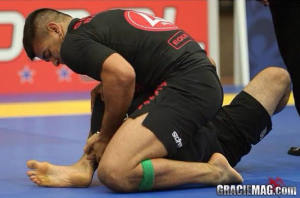To GI Or Not To GI – That is the question (apologies to Shakespeare)
One of the most popular and controversial debates in the world of Brazilian jiu-jitsu is to train in the gi or without the gi?
Since the earliest days of Royce Gracie winning the early UFC’s wearing a kimono, the art and sport of bjj has basically diverged into 3 different training philosophies: MMA, sports bjj with the kimono, and no-gi or submission grappling without the kimono. For the purposes of this discussion we will restrict our debate to gi vs. no-gi.
In the oldest, most established academies of bjj training, in the kimono is the way most classes are taught. In two training trips to Brazil, at world famous academies, I had not seen a single no-gi class on the schedule, despite the several professional MMA fighters on the mat.
In contrast, Eddie Bravo, jiu-jitsu innovator, famously teaches only no-gi and dismisses the kimono as being not essential and even counter-productive to developing the grips required to control an opponent without a collar and sleeves. It is generally acknowledged by both camps that it is easier for kimono trainers to transition to no-gi than the opposite.
 No-gi competition has expanded greatly and coupled with those practitioners who are MMA oriented, the growth of no-gi appears to be increasing world wide with tournaments only in rashguards, shorts and spats. Proponents of no-gi say that training with the gi is only useful for sports bjj, and that it makes no sense if you are going to compete without the kimono, to put on a gi!
No-gi competition has expanded greatly and coupled with those practitioners who are MMA oriented, the growth of no-gi appears to be increasing world wide with tournaments only in rashguards, shorts and spats. Proponents of no-gi say that training with the gi is only useful for sports bjj, and that it makes no sense if you are going to compete without the kimono, to put on a gi!
There is a principle of training known as “specificity of training”: SAID is a training principle that explains that a certain exercise or type of training produces adaptations specific to the activity performed and only in the muscles (and energy systems) that are stressed by the activity. It stands for Specific Adaptation to Imposed Demands.
To go one step further, according to the SAID Principle, the body adapts in a specific fashion to the specific demands that are placed on it. For example, if one does figure skating a lot, one will adapt to the specific skill and strength demands of figure skating (he or she will develop lower body hypertrophy, strength, explosiveness, agility, etc.). In short, to develop a better golf swing, one should train the golf swing; to develop endurance for a marathon, one must train by running long distances.
It seems perfectly logical to train as specifically as possible (ie. no kimono) to prepare oneself for no-gi competition.
Yet very curiously, the champions atop the podium at the most prestigious no-gi championships (ex. ADCC) tend to be competitors who train mostly in the kimono!
How can this be?? I have spoken to multiple ADCC champions about this debate and their opinions have a common theme.
I have spoken to multiple ADCC champions about this debate and their opinions have a common theme.
I paraphrase: They believe that training jiu-jitsu in the kimono sharpens the technique to a degree difficult to attain without the gi. Due to the opponents tighter, greater grips and ability to control the gi, the escapes and controls must be more technical. And thus the kimono trainer theoretically develops their higher level of technique.
These champions admit that in the weeks prior to a no-gi competition they will take off the kimono to adjust their grips and some of their no-gi specific strategies. But they felt that their jiu-jitsu came mostly from gi training.
Both of the largest influences on my own jiu-jitsu training are absolutely adamant that training in the kimono is essential to develop the highest level of technique.
I would like to throw in my own 2 cents on the subject.
One of my favourite bjj quotes is by Ryan Hall who said on his Grapplearts podcast that: “Jiu-jitsu is not a move, it is HOW TO MOVE.”
If I may expand on Hall’s philosophy, he is saying that jiu-jitsu is not the specific techniques we use.
Instead it is the less tangible sense of balance, base, timing, weight distribution, feel of the opponent’s movements, fluidity and speed of ones own movements, use of action reaction, anticipation and so on. If it is more difficult to escape when wearing a gi, the rationale is that the gi trainer will develop sharper escapes than one who might rely more on slippery scrambling and athletic explosiveness without the kimono.
If it is more difficult to escape when wearing a gi, the rationale is that the gi trainer will develop sharper escapes than one who might rely more on slippery scrambling and athletic explosiveness without the kimono.
If there are many more submissions to defend in the kimono, perhaps the gi-trainer will develop better posture and keener awareness of threats; making them more difficult to submit.
In the same way that the jab of Manny Pacquaio is certainly fast and crisp, but not much greater than other pros, it is the other qualities, timing, speed, footwork, reactions that make him elite. It isn’t the specific punch (or the size of the gloves!), it is those other less obvious technical boxing qualities that create the fighter.
If training in the kimono manages to develop these more general qualities to a sharper degree than training without a kimono, this might partly explain why training in the kimono is considered by many jiu-jitsu masters to be the way to the highest level of technical proficiency.
What do you think? Gi or no-gi?

